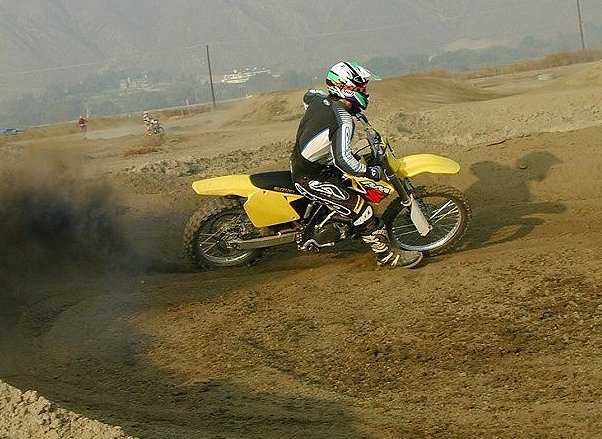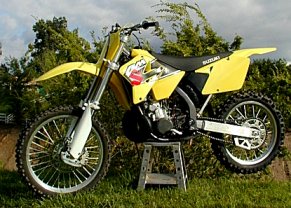
Suzuki’s RM250 is new from the ground up for 2001. Many of the changes, and the incredible weight savings were chronicled in our article dated July 27, 2000. Those details won’t be repeated here, but, once again, these are the highlights.
With an all new motor (lighter), chassis (lighter), and suspension (lighter), Suzuki tried to achieve better engine performance and handling — focusing particularly on weight distribution. Kayaba suspension components (replacing Showa components — long a staple of Suzuki motocrossers) are lighter and, according to Suzuki, perform better than the Showas.
The new engine was designed for improved low to mid-range power and torque, and features a new two-piece, two-stage exhaust power valve system working in tandem with new exhaust ports and a Keihin carburetor with a throttle position sensor.

Suzukis have always felt light, and this year the RM250 truly is light! Did Suzuki retain its legendary corner carving ability and add more straight-line stability? Did Suzuki achieve the ultimate, i.e., 125-class handling with 250-class power?
We rode the 2001 RM250 on a variety of terrain (both on a motocross track and through the trails outside Temecula, California). The first thing we noticed about the new RM is the crisp throttle response — the motor comes on strong with the slightest crack of the throttle. Low-end and mid-range power are impressive — strong and quick, but smooth and controllable.
The motor runs out of steam above the mid-range, but for most amateur riders, the stock RM motor will provide all the performance they need. Pros could move more power up top with pipe, reed and porting changes.
The power characteristics of the new RM250 work well on tight motocross tracks — where you need to clear a double quickly after exiting a turn. With the tiniest stumble right off of idle (which might be cured with a jetting change), the RM quickly pulls from low to mid rpm with a fairly seamless, but quick-revving burst of power. The rear suspension compliments this power by hooking up well while accelerating.
The new Kayaba components have been set up well by Suzuki. The fork, in particular, is very plush, but doesn’t bottom easily. The shock is a little harder to dial in, but worked well after experimenting with the compressing and rebound damping adjustments.

Our final suspension settings: Fork: compression – 9 out, rebound – 13 out; shock: compression – 10 out, rebound – 7 out.
Overall, the RM250 is easy to ride. Our 16 year old tester, Alex Edge (who normally rides a 125) loved the RM250. It was frankly the first 250 he had ridden that didn’t feel big and bulky to him, and seemed to handle almost as well as a 125.
The 2001 RM 250 does feel light and agile on the track, but combines this with reasonably good straight line stability. Despite occasional head shake, the RM inspires confidence through fast, bumpy straights, and then cuts the inside line through the corners.
The ergonomics of the new bike are well thought out, with a flat seat and slim body work that allow the rider to move easily forward to set up for turns, for instance, or backwards to attack whoop sections.

Overall, Suzuki managed a good compromise between straight line stability and cornering. If anything, the new Suzuki is more stable that prior models through fast straights and sweeping turns and, perhaps, trades a small amount of cornering ability for this increased stability. A good trade-off in my book.
In flight manners are also good on the RM250. The plush suspension gives you lots of confidence about your landing, and the bike feels stable, but light in the air.
The clutch and gearbox were typical for Suzuki — they worked extremely well and never failed to engage the next gear.
Suzuki has shown incredible attention to detail when it has revamped a model, street or dirt, during the past few years. The 2001 RM250 clearly reflects this attention to detail, and performs very well right out of the box. The new-found, low-end grunt is exactly what most amateur riders are craving, and the chassis is definitely ready to satisfy pros who want to modify the engine for more top end power. Perhaps, Suzuki hasn’t quite achieved 125-class handling with 250-class power, but it may have come closer than any other manufacturer to date. At an MSRP of $5,899.00, the Suzuki shouldn’t be overlooked when shopping for a 250 motocrosser. The new yellow looks pretty cool too.





